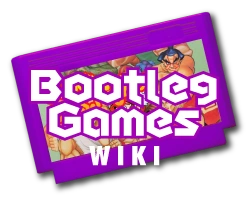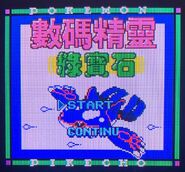Pokémon Ruby (口袋怪獸 聖變石 in Chinese regions, 寵物小精靈 結晶塔之王 in Taiwanese regions) also known as Pocket Monster Ruby and Pokémon Pikecho, is a bootleg game for the Game Boy Color likely released around 2002, possibly 2003. Its title is taken from the then-recent Game Boy Advance game of the same name.
Overview[]
The game puts you in control of Ash Ketchum (Satoshi) (though not explicitly stated as being him) and has you traveling to each town and defeating its leader, much like in the traditional Pokémon games. Interestingly there are no wild battles or experience points, instead you start off with a full team of six early form monsters and collect rubies to evolve them into a higher form. Also worth noting is that you can evolve mons into almost any mon of the next evolutionary stage, meaning you can evolve a Bulbasaur into a Charmeleon or a Seadra. Some of the final evolutionary forms, along with legendary Pokémon, are early form Pokémon like Murkrow.
This game is also a major hack of a title developed by Vast Fame, named Digimon Pocket. Aside from the new graphics and maps, the attack animations and how they work got changed and simplified to match Generation 2 Pokémon moves (only in Chinese releases; the English release still has Digimon Pocket's attacks). The Chinese releases also feature slightly revised music from Shi Kong Xing Shou but keeps the original's intro theme while the English version keeps Digimon Pocket's music.
Trivia[]
- The song that plays in the intro is similar to the Japanese opening theme of the original Pokémon anime's first season.
- The sprites and maps are pulled from Pokémon Gold, Silver, and Crystal.
- This is one of the rare cases of a bootleg game's title actually having meaning outside of tricking consumers. In this case, rubies are actual in-game items used to evolve your Pokémon.
- Despite being named after the (then upcoming) Generation 3 Pokémon game of the same name, there are no Generation 3 Pokémon present in the game.
- The English release of the game has alternate music, moves, and starter Pokémon. The main character's portrait is blue instead of red. The final boss can be challenged at the start of the game. These changes also appear in the hack 數碼精靈 綠寶石.
- A deprotection hack of the Li Cheng version of the game, Chong Wu Xiao Jing Ling: Jie Jin Ta Zhi Wang (宠物小精灵 结金塔之王), was released on generic pirate carts in the early 2000s.




